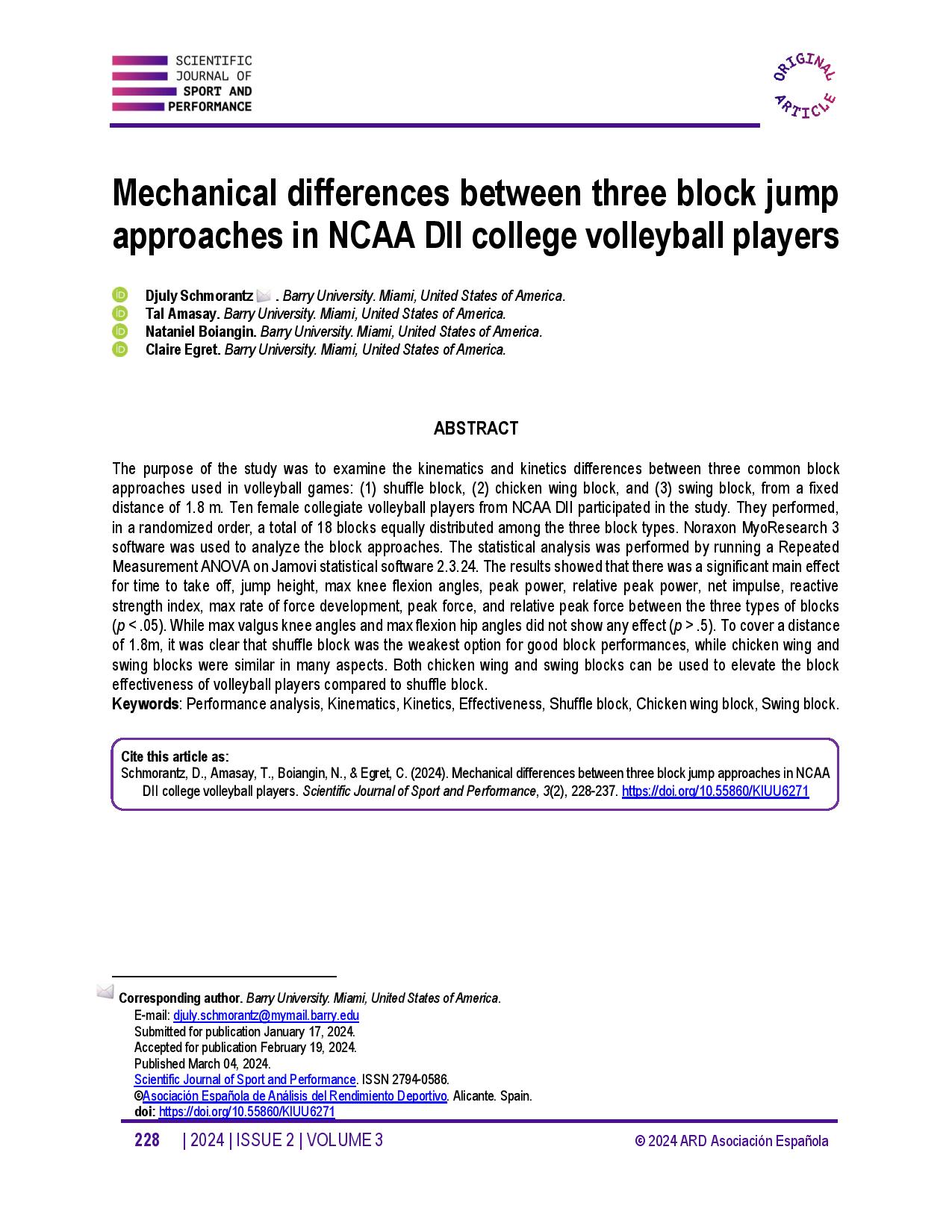Mechanical differences between three block jump approaches in NCAA DII college volleyball players
Main Article Content
Abstract
The purpose of the study was to examine the kinematics and kinetics differences between three common block approaches used in volleyball games: (1) shuffle block, (2) chicken wing block, and (3) swing block, from a fixed distance of 1.8 m. Ten female collegiate volleyball players from NCAA DII participated in the study. They performed, in a randomized order, a total of 18 blocks equally distributed among the three block types. Noraxon MyoResearch 3 software was used to analyze the block approaches. The statistical analysis was performed by running a Repeated Measurement ANOVA on Jamovi statistical software 2.3.24. The results showed that there was a significant main effect for time to take off, jump height, max knee flexion angles, peak power, relative peak power, net impulse, reactive strength index, max rate of force development, peak force, and relative peak force between the three types of blocks (p < .05). While max valgus knee angles and max flexion hip angles did not show any effect (p > .5). To cover a distance of 1.8m, it was clear that shuffle block was the weakest option for good block performances, while chicken wing and swing blocks were similar in many aspects. Both chicken wing and swing blocks can be used to elevate the block effectiveness of volleyball players compared to shuffle block.
Article Details

This work is licensed under a Creative Commons Attribution-NonCommercial-ShareAlike 4.0 International License.
References
Alexander, M., & Honish, A. (2012). Footwork for the volleyball block. Sport Biomechanics Lab University of Manitoba.
Braakhuis, J. G. (2016). Differences in landing impulses between the traditional and swing blocking style in volleyball. Dissertations and Theses @ UNI. 294. Retrieved from [Accessed February 21, 2024]: https://scholarworks.uni.edu/etd/294
Buekers, M.J. (1991) The time structure of the block in volleyball: A comparison of different step techniques. Research Quarterly for Exercise and Sport 62, 232-235. https://doi.org/10.1080/02701367.1991.10608715 DOI: https://doi.org/10.1080/02701367.1991.10608715
Cabarkapa, D., Fry C. A., Cabarkapa, D. X., Rogers, A. C., & Mosier, E. M. (2020). Ground reaction forces of commonly used volleyball blocking approaches. Journal of Kinesiology and Exercise Sciences, 89 (30), 13-20. https://doi.org/10.5604/01.3001.0014.5851 DOI: https://doi.org/10.5604/01.3001.0014.5851
Donà, G., Zorzi, E., Petrone, N., Sawacha, Z., Cobelli, C. (2006). Boimechanical analysis of three different blocking footwork techniques in volleyball: A pilot study. In ISBS-Conference Proceedings Archive. https://doi.org/10.1016/S0021-9290(06)85327-3 DOI: https://doi.org/10.1016/S0021-9290(06)85327-3
Gollhofer, A. & Bruhn, S. (2003). Energy demands in the sport of volleyball. Handbook of sports medicine and science. Volleyball. Eds. Reeser JC, Bahr R. Blackwell Science (pp. 20-28).
Lees, A., Vanrenterghem, J., and Clercq, D. D. (2004). Understanding how an arm swing enhances performance in the vertical jump. Journal of Biomechanics, 37(12), 1929-1940. https://doi.org/10.1016/j.jbiomech.2004.02.021 DOI: https://doi.org/10.1016/j.jbiomech.2004.02.021
Linebach, T. L. (2014). A comparative analysis between traditional and swing blocking among division II female volleyball players. Department of Nutrition and Kinesiology University of Central Missouri.
Lobietti, R. (2009). A review of blocking in volleyball: from the notational analysis to biomechanics. Journal of Human Sport & Exercise, 4; 93-99. https://doi.org/10.4100/jhse.2009.42.03 DOI: https://doi.org/10.4100/jhse.2009.42.03
Mosier, E. M., Fry, A. C., & Lane, M. T. (2019). Kinetic contributions of the upper limbs during counter-movement vertical jumps with and without arm swing. The Journal of Strength & Conditioning Research, 33(8), 2066-2073. https://doi.org/10.1519/JSC.0000000000002275 DOI: https://doi.org/10.1519/JSC.0000000000002275
Moura, T. B. M. A., & Okazaki, V. H. A. (2022). Kinematic and kinetic variable determinants on vertical jump performance: a review. MOJ Sports Medicine, (5), 1. https://doi.org/10.15406/mojsm.2022.05.00113 DOI: https://doi.org/10.15406/mojsm.2022.05.00113
Neves, T.J., Johnson, W.A., Myrer, J.W., & Seeley, M.K. (2011). Comparison of the traditional, swing, and chicken wing volleyball blocking techniques in NCAA division 1 female athletes. Journal of Sports Science and Medicine, 10; 452-457.
Patsiaouras, A., Moustakidis, A., Charitonidis, K., & Kokaridas, D. (2011). Technical Skills Leading in Winning or Losing Volleyball Matches During Beijing Olympic Games. Journal of Physical Education and Sport, 11(2), 149-152. Retrieved from [Accessed February 21, 2024]: https://efsupit.ro/images/stories/7.ASTERIOS_PATSIAOURAS.pdf




